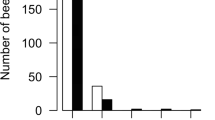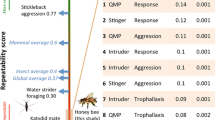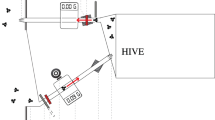Abstract
We tested the hypothesis that Apis mellifera workers exhibit plasticity in moving from fanning to guarding behavior. Bees marked when fanning are more likely to guard than fan on subsequent days, but guard to fanner reversals were common. Our findings suggest that bees can switch between these tasks, but that their bias between the two tasks changes over time, rather than a strict serial progression of worker tasks. The number of fanning workers is positively correlated with ambient temperature and negatively correlated with humidity; this conclusion gives insight into the environmental triggers for worker behavior.


Similar content being viewed by others
References
Breed MD, Robinson GE, Page RE (1990) Division of labour during honey-bee colony defense. Behav Ecol Sociobiol 27:395–401
Couvillon MJ, Robinson EJH, Atkinson B, Child L, Dent KR, Ratnieks FLW (2008) En garde: rapid shifts in honeybee, Apis mellifera, guarding behaviour are triggered by onslaught of conspecific intruders. Anim Behav 76:1653–1658
Crosland MWJ, Ren SX, Traniello JFA (1998) Division of labour among workers in the termite, Reticulitermes fukienensis (Isoptera: Rhinotermitidae). Ethol 104:57–67
Hannelie H, Nicolson SW, Dietemann V (2006) Do honeybees, Apis mellifera scutellata, regulate humidity in their nest? Naturwiss 93:397–401
Johnson BR (2002) Reallocation of labor in honeybee colonies during heat stress: the relative roles of task switching and the activation of reserve labor. Behav Ecol Sociobiol 51:188–196
Johnson BR (2008) Within-nest temporal polyethism in the honey bee. Behav Ecol Sociobiol 62:777–784
Johnson BR (2010) Division of labor in honeybees: form, function, and proximate mechanisms. Behav Ecol Sociobiol 64:305–316
Jones JC, Oldroyd BP (2006) Nest thermoregulation in social insects. Adv Insect Physiol 33:153–191
Korb J, Linsenmair KE (2000) Thermoregulation of termite mounds: what role does ambient temperature and metabolism of the colony play? Insectes Sociaux 47:357–363
Kronenberg F, Heller HC (1982) Colonial thermoregulation in honey bees (Apis mellifera). J Comp Physiol 148:65–76
Kühnholz S, Seeley TD (1998) The control of water collection in honey bee colonies. Behav Ecol Sociobiol 41:407–422
Ratnieks FLW, Anderson C (1999) Task partitioning in insect societies. Insectes Sociaux 46:95–108
Robinson GE, Page RE (1988) Genetic determination of guarding and undertaking in honey-bee colonies. Nature 333:356–358
Robinson GE, Page RE (1995) Genotypic constraints on plasticity for corpse removal in honey-bee colonies. Anim Behav 49:867–876
Seeley TD (1974) Atmospheric carbon dioxide regulation in honey-bee (Apis mellifera) colonies. J Insect Physiol 20:2301–2305
Seeley TD (1982) Adaptive significance of the age polyethism schedule in honeybee colonies. Behav Ecol Sociobiol 11:287–293
Seeley TD, Kolmes SA (1991) Age polyethism for hive duties in honey bees—illusion or reality? Ethology 87:284–297
Siegel AJ, Hui J, Johnson RN, Starks PT (2005) Honey bee workers as mobile insulating units. Insectes Sociaux 52:242–246
Southwick EE, Moritz RFA (1987) Social control of air ventilation in colonies of honey bees, Apis mellifera. J Insect Physiol 33:623–626
Stabentheiner A, Kovac H, Brodschneider R (2010) Honeybee colony thermoregulation—regulatory mechanisms and contribution of individuals in dependence on age, location and thermal stress. Public Libr Sci One 5:e8967
Starks PT, Johnson RN, Siegel AJ, Decelle MM (2005) Heat shielding: a task for youngsters. Behav Ecol 16:128–132
Trumbo ST, Huang Z-Y, Robinson GE (1997) Division of labor between undertaker specialists and other middle-age honey bees. Behav Ecol Sociobiol 41:151–163
Vogt FD (1986) Thermoregulation in bumblebee colonies. I. Thermoregulatory versus brood-maintenance behaviors during acute changes in ambient temperature. Physiol Zool 59:55–59
Wilson EO (1971) The insect societies. Harvard University Press, Massachusetts
Winston ML (1991) The biology of the honey bee. Harvard University Press, London
Winston ML, Punnett EN (1982) Factors determining temporal division of labor in honeybees. Can J Zool 60:2947–2952
Yang MX, Radloff S, Tan K, Hepburn R (2010a) Anti-predator fan-blowing in guard bees, Apis mellifera capensis Esch. J Insect Behav 23:12–18
Yang MX, Wang ZW, Li H, Zhang ZY, Tan K, Radloff SE, Hepburn HR (2010b) Thermoregulation in mixed-species colonies of honeybees (Apis cerana and Apis mellifera). J Insect Physiol 56:706–709
Acknowledgements
We thank the University of Colorado at Boulder for housing the bee colonies used in this study. We are also grateful to M. Ochomogo Krasnec, C. Cook, and L. Sanchez for comments on the manuscript. R.E. was supported by the U.S. Air Force Institute of Technology’s Civilian Institutions Program.
Author information
Authors and Affiliations
Corresponding author
Rights and permissions
About this article
Cite this article
Egley, R.L., Breed, M.D. The Fanner Honey Bee: Behavioral Variability and Environmental Cues in Workers Performing a Specialized Task. J Insect Behav 26, 238–245 (2013). https://doi.org/10.1007/s10905-012-9357-1
Revised:
Accepted:
Published:
Issue Date:
DOI: https://doi.org/10.1007/s10905-012-9357-1




